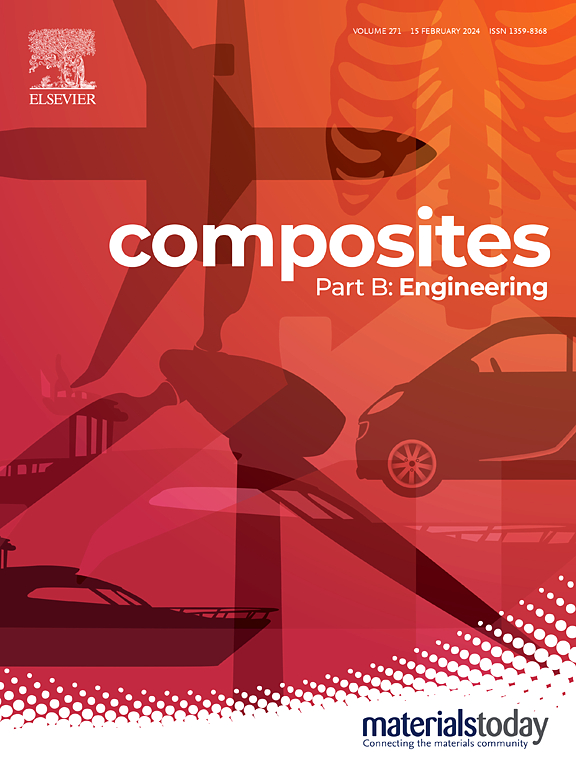聚多巴胺的两种几何形状协同增强碳纤维-环氧树脂界面的附着力
IF 12.7
1区 材料科学
Q1 ENGINEERING, MULTIDISCIPLINARY
引用次数: 0
摘要
本文首先探讨了聚多巴胺(PDA)的两种几何形状,即非晶涂层和纳米微球(PDANPs)对碳纤维的仿生绿色表面改性。与单一的非晶态PDA改性纤维相比,双PDA变体的协同改性能更有效地提高纤维强度和复合材料的界面性能。当非晶态PDA在碳纤维上的反应时间达到96 h时,可吸附更多的pdanp,且分布致密均匀,纤维强度和界面抗剪强度分别提高20.5%和64.4%,这是由于树脂渗透增强、刺状微纳互锁、动态氢键反复耗散能量、环氧分子沿pdanp滑动缓解应力的协同作用所致。和密集pdanp的裂纹缺陷。本文重点介绍了一种有效的、绿色倡议的途径,用于高性能复合材料的界面工程调制。本文章由计算机程序翻译,如有差异,请以英文原文为准。

Two geometries of polydopamine synergistically enhance carbon fiber-epoxy interfacial adhesion
This paper first explores the bio-inspired green surface modification of carbon fiber by two geometries of polydopamine (PDA), that is amorphous coating and nanospheres (PDANPs). Compared to only amorphous PDA modified fibers, synergistic modification using dual PDA variants is more effective in enhancing fiber strength and interfacial performance of composite. When the reaction time of amorphous PDA on carbon fiber reaches 96 h, it could adsorb more PDANPs with dense and uniform distribution, which consequently leads to the maximal enhancements of 20.5 % and 64.4 % in fiber strength and interfacial shear strength due to the synergistic effects of improved resin infiltration, barb-like micro-nano interlocking, dynamic hydrogen bonds that repeatedly dissipate energy, epoxy molecules slide along PDANPs that alleviate stress, and crack defection by dense PDANPs. This paper highlights an effective and green-initiative avenue for the promising interfacial engineering modulation of high-performance composites.
求助全文
通过发布文献求助,成功后即可免费获取论文全文。
去求助
来源期刊

Composites Part B: Engineering
工程技术-材料科学:复合
CiteScore
24.40
自引率
11.50%
发文量
784
审稿时长
21 days
期刊介绍:
Composites Part B: Engineering is a journal that publishes impactful research of high quality on composite materials. This research is supported by fundamental mechanics and materials science and engineering approaches. The targeted research can cover a wide range of length scales, ranging from nano to micro and meso, and even to the full product and structure level. The journal specifically focuses on engineering applications that involve high performance composites. These applications can range from low volume and high cost to high volume and low cost composite development.
The main goal of the journal is to provide a platform for the prompt publication of original and high quality research. The emphasis is on design, development, modeling, validation, and manufacturing of engineering details and concepts. The journal welcomes both basic research papers and proposals for review articles. Authors are encouraged to address challenges across various application areas. These areas include, but are not limited to, aerospace, automotive, and other surface transportation. The journal also covers energy-related applications, with a focus on renewable energy. Other application areas include infrastructure, off-shore and maritime projects, health care technology, and recreational products.
 求助内容:
求助内容: 应助结果提醒方式:
应助结果提醒方式:


